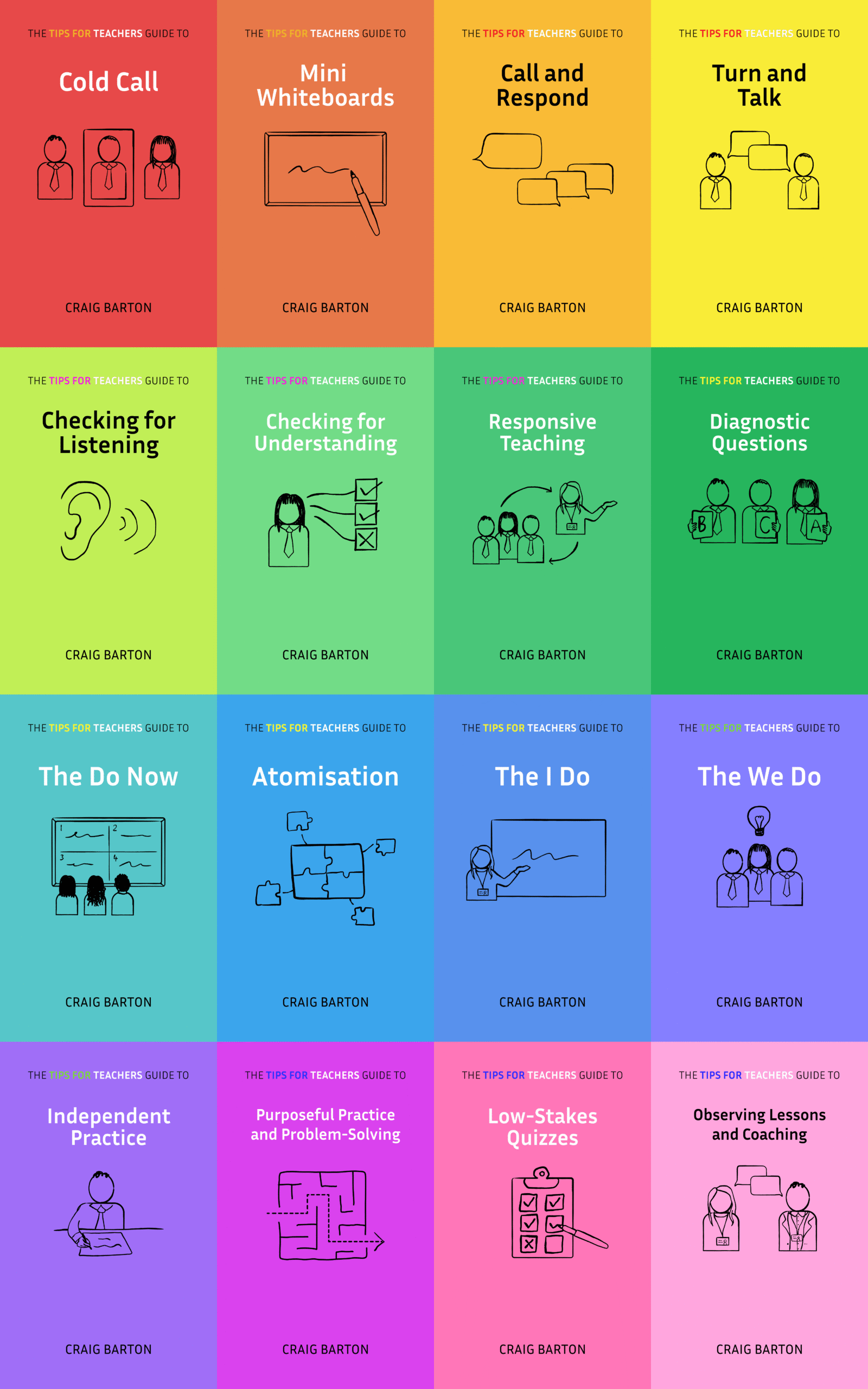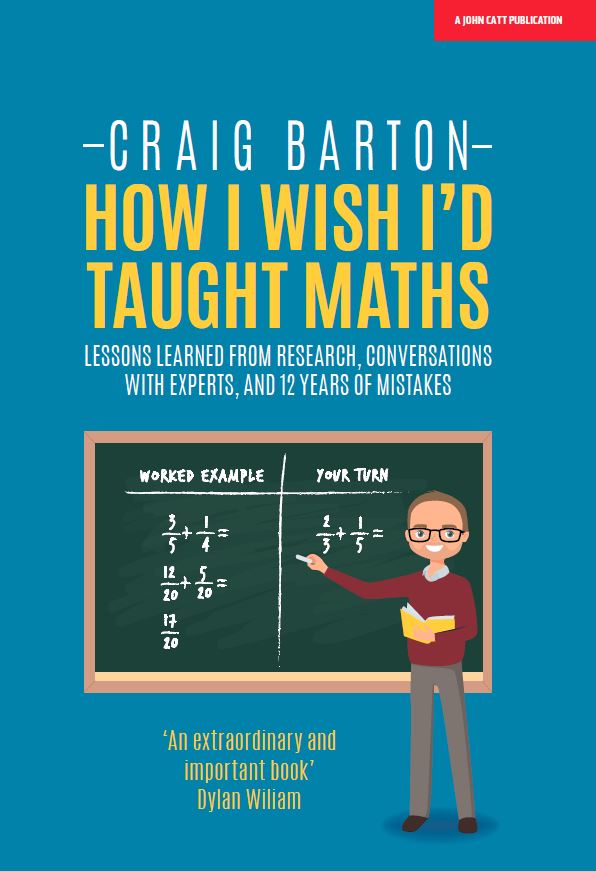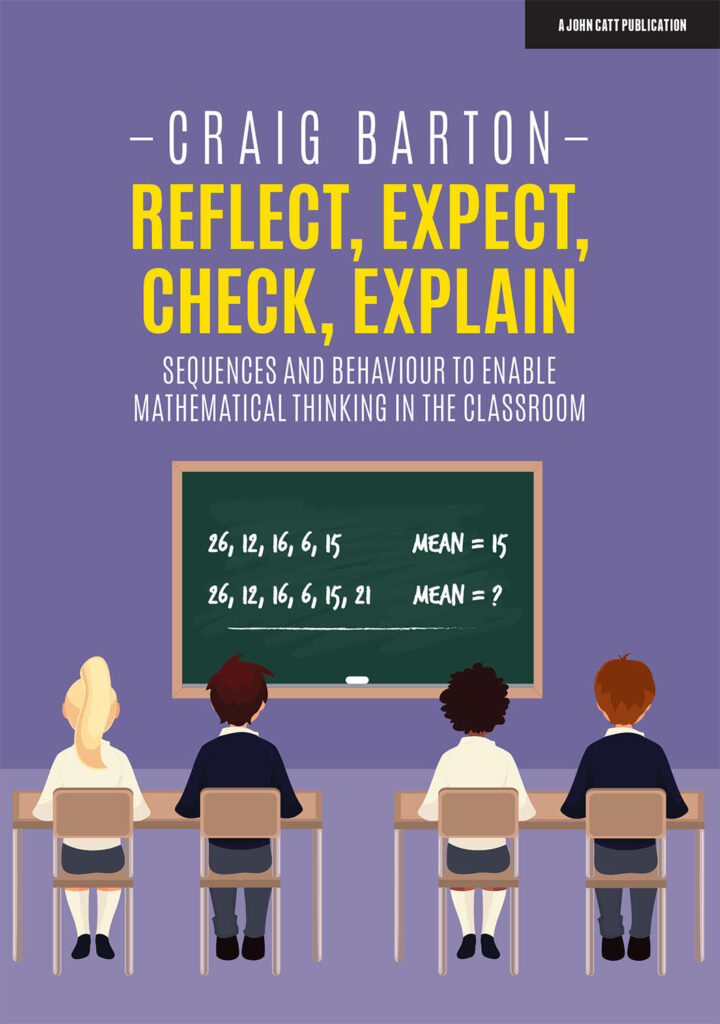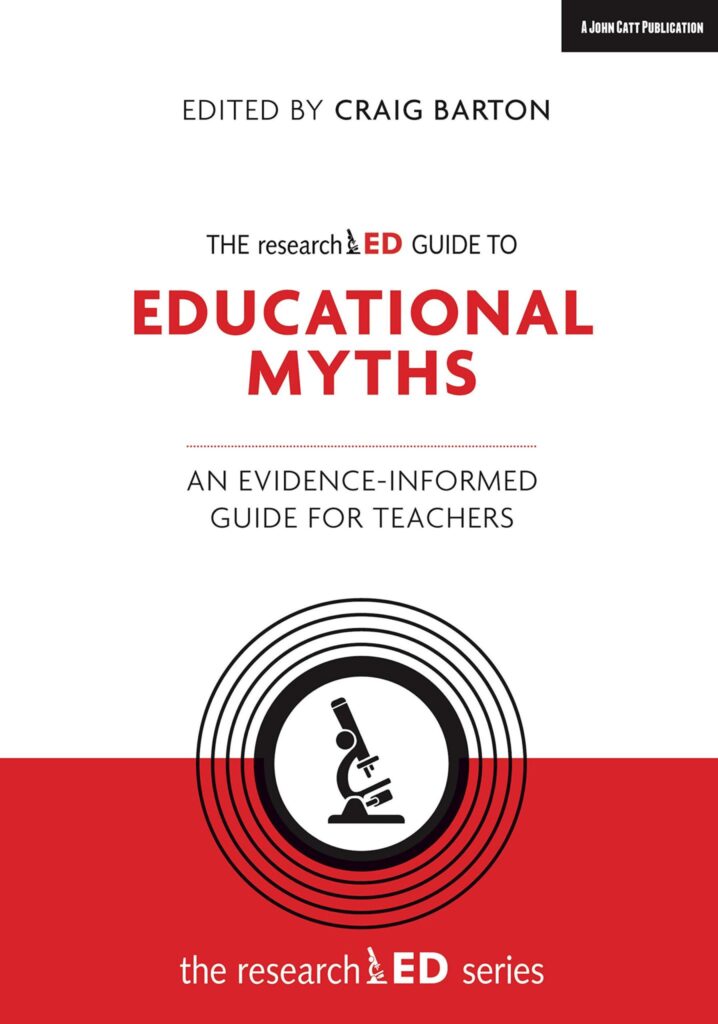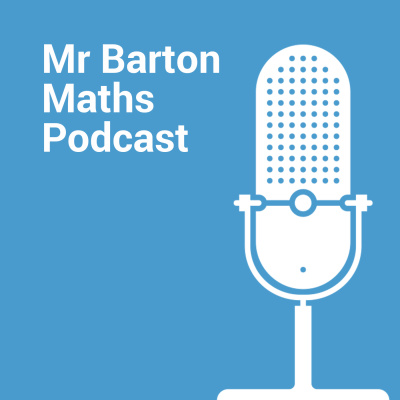
***You can purchase a book on the Do Now in paperback or on Kindle, or a 90-minute online workshop that you can share with colleagues at a CPD event or departmental meeting***
- Diagnosis
- Evidence
- Solution steps
- Part 1: Where does the Do Now fit into a lesson?
- Part 2: Purpose of the Do Now
- Part 3: Structure of the Do Now
- Part 4: Difficulty of the Do Now
- Part 5: Content of spaced retrieval Do Nows
- Part 6: When students are working on the Do Now
- Part 7: Checking for understanding in the Do Now
- Part 8: Responsive teaching in the Do Now
- Part 9: Reasons the Do Now takes too long
- Want to know more?
- Implementation planning
- Book and 90-minute online workshop
The Do Now – sometimes simply referred to as “starter”- is a key part of any lesson. While it may – or should – take only 10 minutes, it sets the tone for what comes next. If you can get students working hard in the Do Now, they will be more likely to work hard for the rest of the lesson. If your teaching can deliver a high participation ratio and good responsiveness during the Do Now, this is also more likely to continue for the rest of the lesson. Of course, the converse is also true.
Diagnosis
Think about your most recent Do Now:
- How did you choose the content?
- How did you check for understanding?
- How easy would it be for a student to lack effort, or lack understanding, during your Do Now and you not pick up on it?
Evidence
Many students can get away with doing very little in many of the Do Nows I see each week. These photos were taken 11 minutes into a lesson:

Students can also get away with understanding very little. In one class, 23 out of 28 students got Question 1 wrong, or left it out. The teacher remained unaware of this.

Students also specialise in a specific type of behaviour during the Do Now. Here is my favourite example:
The teacher started the lesson with a mixed-topic retrieval Do Now. As indicated by the visible timer, students were given 5 minutes to complete the questions in their exercise books.

During this time, the teacher did the register and then quickly circulated the room.
At the end of the 5 minutes, the teacher went through the answers using a combination of Hands-Up and Cold Call. Students were instructed to: “Get out your green Pens. Tick the ones you got right, and correct the ones you didn’t”.
Here is a photo of what one of the student’s books looked like after the teacher had gone through the answers:
Looks pretty good, right? The student has nailed Q1 and Q2. They have struggled on Q3, but have done as instructed and copied down the correct answer. In a book scrutiny, this would be held up as great practice.
But there is a twist…
At the end of the allocated 5 minutes, right before the teacher began going through the answers, this is what the student’s book looked like:
The student had done nothing. Actually, that is not true. She had spent all of the Do Now copying the title and date. From the front of the room (she was sitting at the back), she gave the impression of a student diligently getting on with her work – far more so than some of her peers who were chatting to their partners and drawing the teacher’s attention. When the teacher came near her during circulation, she made an extra effort to appear busy so she wouldn’t be bothered. This is what Adam Boxer calls busy tricking.
When the teacher started going through the answer, the student picked up her pen and began to copy what was written on the board into her book:

If students are presented with a bunch of questions, and they know that the way the teacher will review those questions is to model them, ask for volunteers or Cold Call, then the incentive to busy trick and then just copy down the answers is very high. Student books look amazing, but learning is minimal.
Could anything like this happen in your Do Now?
Solution steps
Part 1: Where does the Do Now fit into a lesson?
In a previous section, I shared my Building Blocks of a Learning Episode:

The Do Now does not feature in this structure (aside from one of the four retrieval opportunities), because the Do Now is a constant. No matter where in the Learning Episode the previous lesson finished, and hence where today’s lesson will start, the Do Now is always the first thing students do when they enter the room. As we will discuss below, a well-chosen Do Now can help settle students, and get them feeling successful, which they can then carry into the rest of the lesson.
Part 2: Purpose of the Do Now
1. Decide on the purpose of your Do Now
Here are four broad categories of Do Nows I see:
1. The settler

The purpose of this type of Do Now is to get kids sat down and keep them busy. This is to get students ready to learn, and so the teacher can deal with any necessary admin and issues before the lesson “starts”. Often these Do Nows will be mathematical, but the amount students learn is a secondary consideration.
2. The prerequisite knowledge assessor

Such Do Nows are designed to ensure the necessary foundations are secure, ready to build a new idea upon.
3. The spaced retrieval opportunity

These Do Nows consist of questions on topics students have encountered at various points in the past, but crucially are not related to the content of the lesson. The aim is to ensure students don’t forget content they have learned previously.
4. The homework supporter

Here, the Do Now consists of questions on topics students have completed in recent homework. The purpose is to see how much students are engaging with homework and also help them see the purpose of what they do outside of lessons.
It is important to be clear on the purpose of each of your Do Nows so you can plan the pedagogy, get students’ buy-in, and design and practice the routines accordingly.
Of course, the purpose of the Do Now may change from lesson to lesson, but that makes the development of those routines much more difficult.
2. Don’t include questions to assess prerequisite knowledge in the Do Now
I think there is a place for each of the Do Now types above, except for one: I don’t think the Do Now is the place to assess prerequisite knowledge. There are three reasons for this
- As we shall see, I like a set number of questions in my Do Now, and this is impossible to achieve if the Do Now is assessing prerequisite knowledge, as some topics will require two questions, whereas others may need 8.
- If students lack prerequisite knowledge, we are obliged to continue supporting them with more explanations and examples until that knowledge is secure. This means we have much less control over the duration of the Do Now.
- If your Do Now is limited to assessing prerequisite knowledge, you are obliged to get to a certain point in each lesson so you are ready to start the next lesson by assessing prerequisite knowledge. This reduces your ability to adapt to the needs of your students.
You may think the answer is to attempt a hybrid structure like this:

This Do Now assesses pre-requisite knowledge in the form of the Last Lesson question and also provides retrieval opportunities for content covered in the past via the other three questions.
But I think this hybrid structure is problematic for these reasons:
- One question is usually insufficient to assess prerequisite knowledge
- You will likely respond differently if knowledge unrelated to the rest of the lesson is not secure, compared to prerequisite knowledge. This can be confusing for teachers and students and means that you have less control over the timing of your Do Now.
I assess prerequisite knowledge during the Atomisation phase of a Learning Episode.

3. Make the purpose of your Do Now to provide a spaced retrieval opportunity
In some schools I visit, behaviour and routines are not yet at the level where the Do Now can be a valuable learning opportunity. In such circumstances, teachers may choose to take a hit and just have a 5-minute settling task while they corral missing students into the lesson, dish out forgotten equipment, deal with behaviour issues, do the register, and so on. Essentially, teachers take a 5-minute hit on the Do Now to give them the best chance of helping students learn for the rest of the lesson. This is far from ideal, but it is certainly understandable.
When such schools improve their routines, we can then choose a purpose of the Do Now that is more focussed on learning. I argued above that it is not a good idea to include questions that assess prerequisite knowledge in the Do Now – I have this as a separate phase of my lesson. So, that leaves us with providing a spaced retrieval opportunity or supporting homework.
I think using class time to support homework is crucial, and something I didn’t appreciate enough for years. It was Adam Boxer who made me see the error of my ways. He describes how he uses the Do Now to support here:
However, I prefer to use a weekly Low-Stakes Quiz to support homework in this way.
Which leaves us with one option.
The sole purpose of my Do Now is to provide a spaced retrieval opportunity for concepts not related to the lesson content. To be clear on what I mean by that, I choose questions on topics that students have encountered at various points in the past, and the act of students thinking hard about those topics strengthens their memory of them, so they will be less likely to forget them in the future. For more on spacing, read this paper.
Of course, through the careful design of such a spaced retrieval Do Now, I aim to settle my class, but settling comes as a by-product of the hard thinking they will be doing.
Limiting myself to this one purpose means I can design Do Nows with a consistent structure, timing, and pedagogy.
4. Ensure your students are aware of the purpose of the Do Now
Ask one of your students why you start the lesson as you do, and they are likely to say something along the lines of: To keep us busy while you do the register. Students who do not know the purpose are less likely to take it seriously.
If your Do Now is a spaced retrieval opportunity unrelated to the lesson, explain to students the importance of retrieval. Show them a diagram of the forgetting curve:

Tell them that every time they think hard about a question in the Do Now, they tell their brains that this is something worth remembering, making them less likely to forget it.
And don’t just tell students the purpose of the Do Now once and then never mention it again. Regularly quiz them on it. Better still, turn the purpose into a Call and Respond and chant it at the end of every Do Now. Here is teacher, Phil Stringer’s, suggestions:
- T: “Why do we review? Why look back?”
- S: “To keep it fresh and stay on track!”
- T: “Why do we retrieve and recall?”
- S: “So knowledge sticks, helps us all!”
- T: “Three questions to start—what’s our goal?”
- S: “Make learning strong, keep it whole!”
- T: “What happens each time we remember and learn?”
- S: “Our brains get stronger at each return!”
If your purpose is different—for example, to assess prerequisite knowledge—communicate this to your students and check that they can tell you.
Part 3: Structure of the Do Now
1. Have a set structure for your Do Now for each class
I once observed a teacher use this question for their Do Now:

Some students sat there, genuinely not sure where to start.
- The structure of the Do Now was unfamiliar – in the last lesson, students were given 5 number operations questions to answer
- There was a lot of text to decipher
- Are those images relevent?
- Students weren’t sure where to write their answers
- Were they allowed to dicuss with their partners?
- Could they use non-integer lengths?
This level of confusion was the perfect excuse for some students to opt out.
Having a set structure to your Do Now in terms of its purpose, the number of questions, the difficulty, where the students answer it, if they are allowed to talk or not, and how you are going to check for understanding – all things we will discuss below – means students can automate the routine and get cracking straight away without any additional input from you.
Here is one teacher’s structure, complete with instructions down the side:

2. Have a departmental structure for your Do Now
I once watched 6 lessons in the same school, and saw 6 different Do Now structures:
This level of inconsistency at the departmental level rarely works. If students share a teacher or move class, they must acquire a whole new routine. Likewise, it makes collaborative or centralised planning more difficult than it needs to be.
3. Make your Do Nows four questions long

If you include fewer than four questions, you miss the opportunity to retrieve them from different curriculum areas.
If you include more than four questions, you cannot rigorously assess students’ understanding or respond appropriately in the time frame usually allocated to a Do Now. That means you end up not taking some questions as seriously as others, which is a slippery slope.
One exception to this is where the teacher includes a 5th Challenge question:


This can work well, especially if one or two students typically finish the Do Now much faster than others. However, if you use this approach, I would recommend:
- Labelling it clearly as a Challenge question so students do not get disheartened if they cannot do it
- Going through the answer to the Challenge question quickly – perhaps a brief explanation and a written solution – and not being drawn into questions and answers about it. Your time and attention should be on the original four questions
4. Don’t have the title and date on the board


Some students love nothing more than easing into a lesson by spending 3 or 4 minutes copying the title and date. This is classic Busy Tricking, as described in the introduction, as it looks like students are working.
Also, if the title gives away the lesson’s focus, it could distract students from the Do Now. Imagine a student who hates Pythagoras’ theorem, and the first thing they do in today’s lesson is to copy down a title of Pythagoras. How will that affect their effort and performance in the Do Now?
Remove this possibility by just having the four questions visible.

Copying the date and title can come later.
5. Consider printing out the Do Now

Printing out the Do Now and having it on students’ desks or handing it to them as they enter the room has a few advantages:
- Students can start right away
- Students don’t waste time copying out the questions
- You can include questions that require diagrams
- All students can see the Do Now
- Students may focus more as they keep their eyes down and not up in the direction of the board
- When stuck in, it looks nice in books… if you are into that kind of thing.
Of course, printing out the Do Now requires more work. More paper is used, time could be lost, and chaos could ensue as students get the glue sticks to stick their sheets in.
Part 4: Difficulty of the Do Now
1. Make the first question of the Do Now an easy one
You don’t want the first question in your Do Now to be a stinker:

Research shows that an easy first question in an assessment leads to a lower dropout rate and higher average scores. Make Q1 of your Do Now super-accessible to reduce the barrier to a student starting.
An easily accessible Q1 also means that if a student does not start, it can only be because they choose not to, instead of being stuck. This means you can hold them to account.
Sure, you take a hit in the retrieval power of that question – the perfect pitch of a question is one that students have almost, but not quite, forgotten how to do. However, you reap the benefits of students taking that momentum and effort into the remainder of the Do Now.
2. Make sure the first question of the Do Now does not require any special equipment
Also, do not pick a question that requires equipment, such as a compass, calculator or a protractor:

Students rustling in their bags, or asking you for the equipment they have forgotten, could derail the focused atmosphere you are trying to create.
3. Pitch the difficulty so students, on average, score 3 out of 4
Students should finish the Do Now feeling like successful mathematicians. They can then carry this momentum into the rest of the lesson. Look at this Do Now:

I watched three students work hard throughout the Do Now, and this was the fruits of their labour:

They did not feel great about themselves when the teacher went through the answers.
Carl Hendrick suggests we aim for an average score of 80% when designing retrieval opportunities such as the Do Now:

So, when planning a four-question Do Now, pitch it so the average student should get three out of four correct. Everyone should nail Question 1. Most students should get Questions 2 and 3 correct. Question 4 can be more of a challenge. This provides the right mixture of motivation and hard thinking that sets the students up for the rest of the lesson.
4. Don’t ask questions with multiple correct answers
I love questions with multiple correct answers… but the Do Now is not the place for them.

If you want a slick start to your lesson, with questions that are easy to check for understanding, then questions with multiple correct answers are not for you. “Sir, is this right?” is not what you want to hear when the clock is ticking.
5. Design Do Nows to last the same amount of time
Do Nows that vary widely in the time they take to complete make it hard to establish routines, both for students completing them and for you when checking for understanding.
So, when designing your Do Now, have a target in mind. I like to aim for:
- 5 minutes for students to be working independently on the Do Now.
- 5 minutes for me to go through the answers
This requires a careful selection of questions, as discussed above
Part 5: Content of spaced retrieval Do Nows
In the following section, I will assume you are following my lead and going for a Do Now, whose purpose is to provide a spaced retrieval opportunity for content not related to the rest of the lesson.
1. Make each question from a different topic, and vary these topics every lesson
I see lots of Do Nows that cover just one topic:

Or repeat topics over a week:

I think this is a missed opportunity. We know providing spaced retrieval opportunities to students is important. Teachers can give students four retrieval opportunities: the Do Now, a weekly Low-Stakes Quiz, homework, and interweaving. If students are not taking advantage of the other three, it is important we maximise the retrieval impact of the Do Now. One way to do that is to ensure we cover as many different areas of maths each week as possible.
2. If the content of your Do Nows repeat over a week, adapt them accordingly
If you do decide to go down this route, you must be responsive. If students nail a particular concept on Monday, there is little point in asking questions of the same difficulty for the rest of that week. Likewise, if students struggle with a topic, there is little point asking a more difficult question the next lesson.


This means that you cannot plan and print your Do Nows for the full week in advance. Tweaks will be needed.
There is a further complication with this Do Now structure: If students do struggle with a question, you are obliged to try to fix the issue there, and then, as you know, they will be quizzed on the same topic in the next lesson’s Do Now. This is the very reason I do not include prerequisite knowledge in the Do Now – I want to have the freedom to move on from any question in the Do Now in the moment and return to it at a later date. When Do Now topics repeat throughout the week, I cannot do that.
I discussed my concerns with this structure on my podcast, and a listener, Martin Ravindran, got in touch to share exactly how he structures his Do Nows and how he addresses the issues I raised. I hope you find the following as useful and interesting as I did:
- First, in the planning stage, teachers should plan 2-3 more retrieval questions than they fully expect students to complete within the allotted time. That means, for example, I might cover 5 topics every day, but I should have 7 topics ready.
- Day 1: Students attempt five of the questions. If they get all five wrong, the teacher can go back to the first one, reteach it for that day, and leave it there. The teacher says, “We will try this again tomorrow, so remember what we did.”
- Day 2: Students hopefully will be more successful with Q1. The teacher may then choose to swap in 1-2 different topics for students so that it’s something different from the previous day. This helps widen the data collected around which topics need addressing, and gives students a bit of a “break” from the stuff they struggled with. The KEY part here is that there will still be 2 more topics students struggled with. The beauty of teacher-paced retrievals is scaffolding. No modifications need to be done to the actual slide. Teachers could just say “We struggled with this one here. I’ll show you the first step, and you can try the last step” or put out a worked example first and then let students try again. If students still fail, they can reteach. If students nail it with scaffolding then… move on.
- Day 3-5: The teacher can slowly mix up the topics, doing more of the ones that need addressing while keeping 1-2 that just need consolidation.
I think the main idea here is that keeping the same topics while planning 1-2 extras gives the following:
- Students who blitz 5 questions have another 2 to do. Teachers don’t have to plan on the spot. Teachers can get a wider spread of data, particularly if its evident studnets are nailing it already, they can swap it out.
- It makes planning easier to plan the same topics for the week with simple variations. Students also get a chance to consolidate. If they didn’t get a good enough dose of consolidation, repeated practice during the week is necessary for the “fluency” part people talk about.
- To address the problems of reteaching and students not getting things, teachers can scaffold/fade guidance throughout the week. I think that’s easier for a teacher to do than for them to do many topics within a week, and be swarmed with data on too many topics that need addressing and not know where to go. Instead, they know they have those 5-7 to work through and can just think of how to scaffold the tasks as the days go by.
- I also actually think it’s GOOD for motivation. I’ve had students within the week be like, “Oh yeah, this was hard” on Monday, but it’s so easy now” on Friday after getting a bit of extra scaffolding on Tue Wed.
3. Track the content of your Do Nows
Each time you include a question in your Do Now, make a note of the concept the question assesses. This allows you to identify any concepts that you have not assessed and fill in the gaps accordingly.
The easiest way to do this is to create a list of skills students have covered over the last 12 months and tick off each time you cover a concept.

Then, add new topics as you cover them.
Mr Taylor takes this to a new level by including a rough percentage of students who get each question correct, so he knows which topics he needs to re-teach, which he needs to revisit immediately, and which he can leave a while.

For a more complete picture, track content across four key retrieval opportunities:
- Do Now
- Weekly Low-Stakes Quiz
- Woven into a topic
- Homework
Here is a snapshot of the system I use, which I explain here.

Of course, you can get all technical about optimal spacing schedules, and the like. But by tracking the inclusion of topics and addressing any gaps, you give your students the best chance of remembering what they once knew.
4. Schedule the content of your Do Nows
One way to ensure you cover all the content you wish to cover in your Do Nows (and indeed, across the other three retrieval opportunities) is to schedule your Do Nows ahead of time. So, you may create a bunch of Do Nows to last a half term, a full term, or even the full year.
Whilst this makes sense from a workload perspective – you can batch the creation or even share it out amongst colleagues – you need to be careful not to lose flexibility. For example, if a question on your Do Now requires students to find the percentage of an amount, and they cannot do it and you intervene in the lesson, you will want to recheck their understanding pretty soon – perhaps during a Do Now later that week. However, that topic may not return for 3 months on your schedule.
A nice way around this is to schedule 3 of the 4 questions in a Do Now ahead of time, and leave the fourth one free to be responsive to the data you have collected on recent Do Nows, either revisiting topics strudetns have struggled with, or including more challenging questions on topics that students have seemingly nailed.

5. Consider avoiding certain topics in your Do Now
Some topics rarely get assessed in Do Nows:
- Loci
- Constructions
- Measuring angles
Each of these topics requires specialist equipment. And if your students do not have that equipment on them, it is likely to derail the calm, focussed atmosphere you are hoping to create during the Do Now.
I don’t think the Do Now is the place to include questions that require special equipment if your students are unlikely to have it on them. For some classes, any question requiring a calculator may also fall into this bucket.
Of course, students need opportunities to retrieve knowledge of such concepts. Considering the four retrieval opportunities we discussed above, I think a weekly Low-Stakes Quiz is the place for such questions.
Part 6: When students are working on the Do Now
1. Consider using a visible timer

A visible timer allows students to pace themselves, and stops the Do Now overrunning.
I start the timer when I have a critical mass of students in the room. Depending on the time of day or the group of students, this could be a few minutes after the bell.
Of course, nothing ever goes completely to plan, so you might need to flex the timings in either direction when you circulate…
2. Circulate, register, circulate
The register usually needs doing in the first few minutes of a lesson, so an ideal time to do this is while students are working on the Do Now. However, do a quick circulation first. This gives you a better chance of spotting any students who have either not started, or are busy tricking, than you can from your vantage point at the front of the class.
Then complete the register, then circulate again. This second circulation again helps you check for effort, but may also give you valuable information about whether students have enough (or too much) time and give you an early indication of any difficulties students are having. It can also be used to give out the mini-whiteboards.
3. Tell students not to copy the question

Copying the question is classic busy tricking behaviour. Students give the impression they are working hard when, in reality, they are doing very little thinking.
If copying the question helps with the working out, such as writing out an equation that needs solving, then fair enough. But apart from those few exceptions, have the rule that all students put in their books is their working out and the answer.
One teacher made this expectation explicit to his students:

4. Decide what you want students to do when they are stuck
I’ve watched many a Do Now where students have sat there doing nothing for several minutes. When the teacher eventually spotted this and questioned them, they replied with the immortal line: I’m stuck.
Pre-empt this by deciding in advance what you want students to do if they are stuck. Should they:
- Look in their notes?
- Ask their partner?
- Ask you?
- Write down what is confusing them?
- Move on to the next question?
And of course, it is one thing for you to decide this. It is another ball game ensuring students know what you expect of them. Print it out, regularly quiz them, do whatever it takes to ensure students know what to do if they are stuck during the Do Now.
Personally, I am a fan of telling students to move onto the next question, and then when they have done all that they can do, spend the remaining time writing down everything they can remember from the last lesson. The reasons I choose this approach ahead of any other are:
- I want students to see what they can remember without access to cues (so I don’t want them looking back in their notes)
- I want students to work in silence (so I don’t want them to ask their partners)
- I want to be free to circulate, do the register, and get stuff sorted for the lesson (so I don’t want them asking me)
- It sounds good in theory to ask students to write down what it is that is confusing them, but I rarely find it works.
- I want them to do something, so opting out isn’t all-to-tempting. Writing down what they can remember from the last lesson primes them for what will come.
5. Consider providing avoidable hints and cues
Another option for students who are stuck is to use a hint that you have provided.
I am not a fan of unavoidable hints like these:

Students should be able to see what they can remember without having a hint shoved in their faces. So, perhaps hints in the form of related worked examples on the back of the Do Now sheet or on the board is a good alternative:

Teacher workload is a significant consideration here. If creating these avoidable hints is too much, then I would choose no hints over unavoidable ones and ask students to move on and then do the previous lesson brain-dump as described above if they are stuck on a question.
Part 7: Checking for understanding in the Do Now
Let’s return to one of the questions I posed at the start:
How easy would it be for a student to lack effort, or lack understanding, during your Do Now and you not pick up on it?
In Do Nows, where the teacher goes through the answers, asks for volunteers or Cold Call students, I think the answer to this question is very easy. Students can sit there busy tricking, waiting for the teacher or someone else to tell them the answer, and then neatly copy this into their books, green pen and all, giving every indication they know what they are doing.
Let’s solve this problem…
1. Use Book-to-Board: One question at a time
Having experimented with many ways of checking for understanding during the Do Now, the one I think works best is this:
- Students complete their Do Now in their books or on sheets
- When it is time to go through the answers, the teacher asks all students to copy their final answer to Question 1 on their mini-whiteboards, hover and show in 3, 2, 1
- They respond accordingly (more on this below)
- Then repeat for Question 2

This gives you a much more reliable sense of effort and understanding of all students than you get from either just going through the answers yourself, or asking one or two students what they did.
It may be tempting to try and check all four answers in one go. Resist! There is too much data on boards, and things always get missed:

Ollie Lovell does a variation of this approach that we discussed here:
- Students complete their Do Now in their books or on sheets
- When it is time to go through the answers, the teacher asks all students to copy their final answer to Question 1 on their mini-whiteboards, hover and show in 3, 2, 1
- The teacher makes a note of the approximate proportion of students who got the question correct
- Then repeat for Question 2
Ollie likes gathering data on all four questions before responding to any individual question. He argues this helps him allocate time more effectively, now that he has an overview of student understanding across the entire Do Now.
Finally, the success of either approach to Book-to-Board lives and dies on the routines established around mini-whiteboards. Read here for (much!) more on this.
2. If the Do Now is all on mini-whiteboards, then working on one side, answer on the other
Some teachers ask their students to do their entire Do Now on mini-whiteboards. The benefits are:
- Students may be more willing to try questions they are unsure of on a mini-whiteboard than in books.
- The teacher may find it easier to hand out mini whiteboards at the start of the lesson (or have them left on the desk from the previous class) than hand out the books
- Students may write bigger on their mini whiteboards, making checking for understanding during circulation easier than writing in books.
If you want students to do all of their Do Now on their mini-whiteboard, then ask them to do all their working out on one side, and then write the final answer to Question 1 on the other side when instructed:

This stops you from being overwhelmed by data, increasing the reliability of your check for understanding.
3. Adapt if the question is not suited to being checked on a mini-whiteboard
We discussed above how the Do Now is not the place to assess questions that are hard to quiz. However, you might still include some questions that are not best suited to being assessed on mini-whiteboards. Definitions are a good example – the words in the sentence may be too hard to read on the mini-whiteboards of every student. In these situations, you can:
- Ask students to check each other’s work
- Set up a Call and Respond
- Do some rapid-fire Cold Calls
4. Encourage latecomers to join in during the check for understanding
Many schools have an issue with students arriving late, either due to the geography of the school building or students not exactly hurrying to get to class.
If some students arrive after the 5 minutes of independent practice has finished, ask them to join in the Do Now on their mini-whiteboards.
5. Consider checking each answer and then responding at the end
Above, I suggest you check the answer for Question 1, respond, then check the answer for Question 2, respond, and so on. An alternative is to check the answer for each question in turn (“Show me your final answer to Question 1… thank you. Now rub it out and show me your final answer to Question 2...”), note down the rough proportion of students who have each question correct, and then respond at the end.
The main benefit of this approach is that you can allocate time appropriately as you have the full picture of understanding across the Do Now. So, you may choose, for example, to not spend as much time responding to Question 1 because you have seen that more students have struggled with Question 3.
6. If behaviour or focus is an issue, consider showing one question at a time
One teacher I coached found that his students struggled to do much at all during the 5 minutes they should have been working independently on the Do Now. Here are some photos of their books at the point the teacher is about to go through the answers:

However, when the teacher asked students to write their answers on their mini-whiteboards, they were all happy to participate.
So, we decided to experiment by removing the 5-minute independent practice phase, and instead just have Question 1 visible. Students could then be given a much shorter time frame to answer the question on their mini-whiteboards.
So, instead of this:

Just have this:

Students can be given, say, 30 seconds to do their working out on the back of their mini-whiteboards, write the final answer on the front, hover and show you in 3, 2, 1…
Respond, and then repeat for Question 2.

This led to a much faster, more focused start to the lesson, which is precisely what some classes need. Latecomers also have more opportunity to join in with the rest of the class than when Do Nows are done in the more traditional way.
Part 8: Responsive teaching in the Do Now
A key mistake many teachers make throughout lessons, but especially during the Do Now, is spending too long on questions where understanding is secure, and not long enough on questions where students are struggling.
Take this example:

The teacher spent just as long going through Question 2 that everyone got correct, as she did going through Question 4 which most students struggled with.
Now that we have a good sense of student understanding from their mini-whiteboards, we can allocate our time efficiently by responding differently to two different scenarios.
1. Have each original question ready on separate slides
It may be tempting to try and squeeze the answer and working out on to the original Do Now slide. But this gets messy very quickly:

Instead, copy and paste each original Do Now question onto the top of its own slide, so it is ready for you to do clear working out on.


Now we are ready to respond.
I use a simplified version of the model I discuss here.
That model looks like this:

For the Do Now, I do this:

Notice:
- The middle scenario has been removed. This is for time. I want to get the Do Now boxed off in 10 minutes maximum.
- For the same reason, there is no What If option in the top scenario. If 80%+ of students show the correct answer, I will move on.
- In the bottom scenario, I will move on in the moment regardless of whether students answer the follow-up question correctly, but I will make a note to revisit the top if students struggle.
Let’s now dig into those steps in more detail…
2. If 80%+ of students have the correct answer, confirm and move on
If the mini-whiteboards suggest the majority of students have got it (80% is the proportion I go with), confirm the answer, quickly model how to do it on the board in case students mishear, and then move on to the next question.
It may be tempting to ask a student to talk you through the answer or ask some probing questions to delve a bit deeper, but this takes time, and my argument is that time is better spent on a question where more students have struggled.
3. If <80% of students have the correct answer, model and recheck for understanding
If the mini-whiteboards suggest a significant number of students have a misunderstanding, the response must be different. Again, while asking students with different answers to explain their thinking may be tempting, this takes time and can confuse them.
I favour a clear, concise explanation from the teacher, referring to students’ wrong answers where appropriate. Writing the students’ answers on the board can help with this:

I can see why some people thought it was 24.0, but we need to make sure our answer only has one significant figure…
Next, we need to check their understanding. “Does this make sense?” will not cut it. We need a follow-up question, one that assesses the same skill as the original question but still requires some thinking.
So, if our original question asked students to write “seven tenths” as a decimal number, the follow-up question might be to write “three hundredths” as a decimal number.
If our original question asked students to find the median of 8, 10, 13 and 14, our follow-up question might ask them to find the median of 2, 3, 5, 9, 11, 20.
Get students to answer these follow-up questions on their mini-whiteboard, doing working out on one side and final answer on the other.
4. Prepare follow-up questions in advance and have each on a separate slide
It can be tempting to create follow-up questions in the moment, but I would advise against it. You risk creating a bad question or not being able to think of a question in time due to the nature of the topic.
Preparing follow-up questions in advance and putting one on each slide after its corresponding original question means you can do your thinking outside of the classroom:


If 80%+ of students get the original question correct, just skip the follow-up question.
5. Consider setting out your original question and follow-up question as an Example-Problem Pair
Instead of putting the original question and follow-up question on different slides, some teachers prefer the Example-Problem Pair layout:

The advantage here is that students have the support of the original example as they attempt the follow-up question. The disadvantage is that you have a less reliable test of their understanding as they have an unavoidable hint.
A nice solution is to go for the Example-Problem Pair layout, and then rub out your working out if you feel students do not need the support as they attempt the follow-up question.
6. If students struggle with the follow-up question, move on…
If many students still cannot answer the follow-up question correctly following your explanation, then it is best to move on. Tell the students not to worry and that you will come back to this when you have had a chance to think how to explain it better.
This is one of the reasons I advise against including prerequisite knowledge in the Do Now. You cannot move on in that case, as students need that knowledge for the lesson.
7. … but ensure you revisit the topic properly
Moving on in the moment is fine, but you need to schedule some time to revisit the topic. I see many examples of students struggling with a question in the Do Now, and the teacher asks a similar question again a few days later. Unsurprisingly, many students get the question wrong again. Like the significant figures questions here:

The only way to combat this is to dedicate lesson time in the future to revisiting this topic, armed with a clear, concise explanation and lots of opportunities to practice.
Part 9: Reasons the Do Now takes too long
One of the most common concerns from teachers is that the Do Now is taking too long, sometimes 20 or even 30 minutes. This means that the rest of the lesson is rushed, leaving little time for consolidation or problem-solving.
Having seen 1000s of Do Nows in the last few years, here are the most common reasons Do Nows take too long, along with possible solutions:
Reason 1: Students arrive late to lessons, so the teacher has to wait for these students to finish
Solution: Lateness to lessons is a common problem in the schools I visit. It must be tackled at a whole-school level, with consistent rules, active monitoring, and appropriate sanctions. However, in terms of what you can control, I advise “starting” your Do Now – in other words, beginning the countdown for however long you want students working on your Do Now – when you have a critical mass of students in the room. If you ask students to transfer their answers from their books to their mini-whiteboards one question at a time when you review answers to the Do Now, those latecomers can join in at that stage so they do not miss out entirely.
Reason 2: The teacher needs to keep reminding students of the Do Now routine (e.g. don’t copy the question out, do the working out in your books, silence when working on the questions, etc)
Solution: When introducing anything new – such as a different way of running your Do Now – the routine is unfamiliar to students. So, it is inevitable that the first few iterations will take longer than you would hope. But don’t cut corners or lower your standards. Invest the time in perfecting the routine now, safe in the knowledge it will save time in the many Do Nows to come. You can speed things up by initially reducing the content demands – make your first few Do Nows relatively easy so more of students’ attention can be on the routine rather than the content of the Do Now.
Reason 3: Students take longer than they should to answer each question
Solution: Students often need an incentive to work briskly, especially during the Do Now. Four things help here. First, start a visible timer when you have a critical mass of students in the room. Second, circulate the room, then do the register, and then circulate again. Third, remind students that they will be asked to show their answers to each question on their mini-whiteboards and will be held accountable if they do not. Fourth, ensure students know the purpose of the Do Now – if they think it is just a few questions to keep them busy, they will likely labour over it.
Reason 4: Students work swiftly through the Do Now, but it still takes them a long time to finish all the questions
Solution: The Do Now is probably too long. When planning a Do Now, I advise aiming for most students to finish it in 5 minutes. For maths, this usually means a 4-question Do Now, made up of single-part, predominantly procedural questions. Even if students could answer more questions in that time, it will take you too long to review the answers properly.
This is also why I advise not using the Do Now to assess prerequisite knowledge for the upcoming lesson. Topics do not require the same number of prerequisite knowledge questions, so you cannot have a consistent structure for your Do Now. Also, you lose the flexibility to move on if students struggle with a question in the Do Now. I advise making the Do Now a spaced retrieval opportunity, using content unrelated to that of the lesson, and assessing prerequisite knowledge in a separate lesson phase after the Do Now.
Reason 5: Students get most of the questions wrong, so time is needed to model and recheck for understanding.
Solution: Don’t pitch your Do Now too hard. A success rate of around 80% is a good goal. So, for a four-question Do Now, you should write it expecting the average student in your class to get 3 out of the 4 questions correct. At most, you should need to model and recheck for understanding for two of the questions. If you need to do more than this, your Do Now is too hard for your class.
Reason 6: Students get most of the questions correct, but the Do Now is still taking too long
Solution: Many teachers I observe have a habit of spending too long after a check for understanding reveals knowledge is secure. If the mini-whiteboards show that 80%+ of your students have the correct answer, don’t be tempted to ask one student to explain their thinking and then another student to comment on that answer. Instead, confirm what that answer is – writing it down and adding a quick verbal explanation – and then move on. Aim to do so within 7 seconds. Your time is better saved for the questions where students struggle.
Reason 7: Responding when students’ knowledge is not secure is taking too long
Solution: When students’ mini-whiteboards show fewer than 80% know the correct answer, do not be tempted to probe students more, especially if you can identify the nature of the misunderstanding from their answer. If students knew how to answer the question, they would have written the correct answer when you first asked them to. Instead, offer a clear and concise explanation, referring to common wrong answers where appropriate. Then, use the time you save to get more reliable evidence of understanding by asking all students to respond to a follow-up question.
Want to know more?
- Mr Taylor describes how his Do Now in maths has developed here
- Adam Boxer talks about the first 10 minutes of his lesson here
- Blake Harvard has a great post entitled 5 Reasons My Class Begins with Retrieval Practice (Almost) Daily here
Implementation planning
Here are the ideas we have discussed:
Part 1: Where does the Do Now fit into a lesson?
Part 2: Purpose of the Do Now
- Decide on the purpose of your Do Now
- Don’t include questions to assess prerequisite knowledge in the Do Now
- Make the purpose of your Do Now to provide a spaced retrieval opportunity
- Ensure your students are aware of the purpose of the Do Now
Part 3: Structure of the Do Now
- Have a set structure for your Do Now
- Have a departmental structure for your Do Now
- Make your Do Nows four questions long
- Don’t have the title and date on the board
- Consider printing out the Do Now
Part 4: Difficulty of the Do Now
- Make the first question of the Do Now an easy one
- Make sure the first question of the Do Now does not require any special equipment
- Pitch the difficulty so students, on average, score 3 out of 4
- Don’t ask questions with multiple correct answers
- Design Do Nows to last the same amount of time
Part 5: Content of spaced retrieval Do Nows
- Make each question from a different topic, and vary these topics every lesson
- If the content of your Do Nows repeats over a week, adapt them accordingly
- Track the content of your Do Nows
- Schedule the content of your Do Nows
- Consider avoiding certain topics in your Do Now
Part 6: When students are working on the Do Now
- Consider using a visible timer
- Circulate, register, circulate
- Tell students not to copy the question
- Decide what you want students to do when they are stuck
- Consider providing avoidable hints and cues
Part 7: Checking for understanding in the Do Now
- Use Book-to-Board: One question at a time
- If the Do Now is all on mini-whiteboards, then working on one side, answer on the other
- Adapt if the question is not suited to being check on a mini-whiteboard
- Encourage latecomers to join in during the check for understanding
- Consider checking each answer and then responding at the end
- If behaviour or focus is an issue, consider showing one question at a time
Part 8: Responsive teaching in the Do Now
- Have each original question ready on separate slides
- If 80%+ of students have the correct answer, confirm and move on
- If <80% of students have the correct answer, model and recheck for understanding
- Prepare follow-up questions in advance and have each on a separate slide
- Consider setting out your original question and follow-up question as an Example-Problem Pair
- If students struggle with the follow-up question, move on…
- … but ensure you revisit the topic properly
Use these ideas to complete the prioritisation exercise here.

Book and 90-minute online workshop

***You can purchase a book on the Do Now in paperback or on Kindle, or a 90-minute online workshop that you can share with colleagues at a CPD event or departmental meeting***
